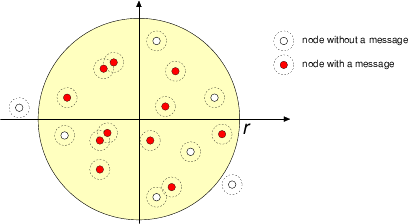Floating Content
People are increasingly using online social networks for maintaining contact with friends and colleagues irrespective of their physical location. While such services are essential to overcome distances, using infrastructure services for location-based services may not be desirable, for example for privacy reasons.
In the floating content work, we have designed and analyzed a fully distributed variant of an ephemeral content sharing service, solely dependent on the mobile devices in the vicinity using principles of opportunistic networking. The result is a best effort service for floating content in which content is created locally, its availability is geographically limited and its lifetime and spreading depends on interested nodes being available.
Although similar contents have been "floating" around already for the past 10, even 15 years, what sets our work apart from existing work is that we have very thoroughly analyzed the feasibility of floating content and identified the effects of a variety of system parameters on the performance of the system. Our work covers both mathematical modeling, simulated experiments with real-world mobility traces, real-world measurements, and prototype implementation. This approach has served us well and has enabled us to research many interesting aspects of the floating content problem space.
Operation Principles
In Floating Content, a message (a text message, an image, etc.) deemed to be of interest to other people at a certain area is tagged with geographical coordinates of that area. This area is referred to as the anchor-zone of the message.
|
A message is disseminated in opportunistic manner whenever two nodes meet within the anchor-zone. Outside the anchor-zone, nodes are free to delete it. The unique characteristics are that the scheme does not rely on any infrastructure (cf. privacy aspects), a message can only be created and distributed locally, and it cannot be deleted afterwards. Therefore, assuming there is a sufficient number of nodes in the anchor-zone, a message remains available within the anchor-zone until it expires. Due to stochastic fluctuations, however, there is a finite probability that the message gets deleted before the expiration time (best effort). A complete system involves many parameters and must be evaluated by simulations, while the fundamental properties can be studied analytically (by means of stochastic processes, transport theory and fluid approximations).People
|

Figure: Floating Content and its anchor-zone. |
References
Links:
- Visualization of the floating content with the ONE simulator
- Floating content in action (a simple java applet).
- Square mobility model